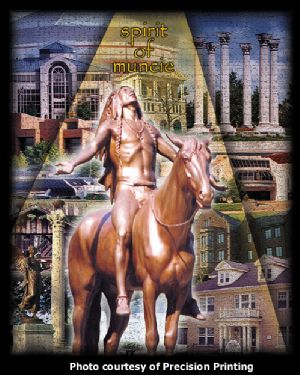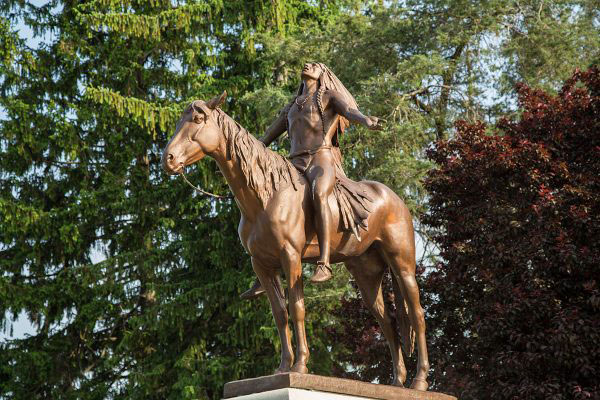
Delaware County
The following historical narrative has been provided courtesy of:
Delaware County is located approximately sixty miles northeast of Indianapolis and is bounded by Grant and Blackford Counties on the north, Jay and Randolph Counties on the east, Henry County on the south and Madison county on the west. Since its organization in 1827, Delaware County has grown from a small Indian village to an important manufacturing center.
The County was named for the Delaware Indians, an Eastern tribe which was slowly pushed into Ohio and finally settled in east central Indiana during the 1770’s. The Delaware Indians established several towns along the White River, among these Munseetown , near present day Muncie. In 1818, under the Treaty of St. Mary’s Ohio the Delaware ceded their holdings in Indiana to the United States government and moved westward. In 1820, Delaware County was opened for settlement.
The first permanent white settler was Goldsmith Gilbert, born in New York in 1795. He moved to Delaware County in 1823 and established a trading post in the northern part of the County. The post was burned and with the money he was awarded in compensation by the United States government, in 1926 he bought 672 acres from an Indian widow named Rebecca Hackley. The Hackley Reserve, as it was called, became the center of present day Muncie. Gilbert built two log cabins and the village began to attract other settlers.

On January 26, 1827, Delaware County was organized; at that time it had about 1,000 residents. Shortly after, the village of Munseetown was established as the County seat. Because of poor transportation, the county grew slowly. Roads were built beginning in the 1830’s and 1840’s, and the first turnpike linking Muncie with Cambridge City opened in the early 1850’s. However, the coming of the Indianapolis and Bellefontaine Railroad in 1852 opened up new agricultural markets to the South so that between 1850 and 1870, the population of Delaware County nearly doubled. Most of the County’s small towns were laid out along railroad lines. These included Desoto, Cowan, Oakville, and Royerton.
The coming of the railroad had an important effect on the village of Munseetown. Before the line was extended from Indianapolis to Muncie, the town simply consisted of a cluster of houses and businesses around the village square. The Muncie Seminary, the first private school in Delaware County located at West Jackson and Gharkey Streets, was considered “out in the country” in 1846. The 1850 population was 666.
The railroad made Muncie a trading center for the county. Farmers brought their produce, livestock, and grain to ship to outside markets. By 1854, Munseetown was incorporated as a town and became Muncie. In 1865 it was incorporated as a city with John Brady elected as Muncie’s first mayor.
The Civil War brought increased prosperity not only to Muncie but to the county. Delaware County’s population almost doubled to 23,000 between the years 1860-1880. During these years, Muncie began to evolve into an industrial city. By 1880, Muncie had forty factories, manufacturing products ranging from washing machines to roller skates. During the next few years, more than a dozen new industries opened.
One of the industries which located in Muncie would shape the town’s future and is a strong force in the city even today. In 1888, five brothers from Buffalo, New York moved to Muncie after their glass factory had burned. Ball Brothers became one of the largest employers in Muncie and their Ball jars and other glass products were shipped throughout the country.
During the 1890’s, additional businesses located in Muncie including Midland Steel, Indiana Iron Works, and the Muncie Wheel Company. Many of these firms were brought to Muncie as a result of the Citizens Enterprise Association, a group which raised over $200,000 to encourage and finance new industry.
In addition to the gas booms, several other major events changed the character of Delaware County and increased the importance of Muncie as a major city. By 1900 the Union Traction Company had opened an interurban line between Muncie and Anderson. The interurban passed through many of the country’s smaller towns and cities. The opportunity to easily and inexpensively travel to a larger city to make purchases and conduct business decreased the economic importance of smaller towns. This became more evident when the interurban extended its service to Indianapolis early in the century.
Another factor in the centralization of Delaware County was the consolidation of schools in 1899. Up until 1890, almost one-half of the county’s school population went to one room schools. Each township was responsible for maintaining its own schools, usually numbering about ten. However, when the school districts began to consolidate, these one room schools began to be abandoned for more centralized, larger schools. Six room schools opened in many of the outlying towns such as Royerton and Selma and many students began traveling further from their rural homes to the classroom.
In 1917, the Ball Brothers bought what had previously been the Eastern Indiana Normal University and offered the property to the State. The school opened as a teachers college in 1918. The college is now known as Ball State University.
During the 1920’s, Muncie became the subject of an in-depth study conducted by two sociologists, Robert and Helen Lynd. Their book, “Middletown,” used Muncie as a typical midwestern town and studied the city’s past, values and lifestyles. In 1937, the Lynds published a second book entitled, “Middletown in Transition.”
Chief Muncie
“This memorial statue, sculpted by the distinguished artist, Cyrus Dallin, was first seen by my Mother in the Center Park of the City of Boston. It was named “The Appeal to the Great Spirit.” It seemed to her to be most fitting for my father’s memory because it expressed so many attributes and interests of her husband.
When my mother saw this statue, she was determined that this was the memorial for her husband she wanted, and this would be its location, on the banks of the river. And, as my mother was a very determined lady, the statue came to Muncie.

There are two full size “Appeal to the Great Spirit” statues. One, as I mentioned, is in the Center of the City of Boston and the other is here in the City of Muncie. Cyrus Dallin, the sculptor, came to Muncie to approve the statue’s location, its surrounding landscaping and the stone-masonry work on which it stands and is surrounded. I can state positively that he approved, because I was there and I heard him.
I’m sure my Mother and Father both would be pleased with the respect and honor which our citizens here respect and refer to this statue. It has become the community’s emblem, symbol, signature-for lack of better words.”
